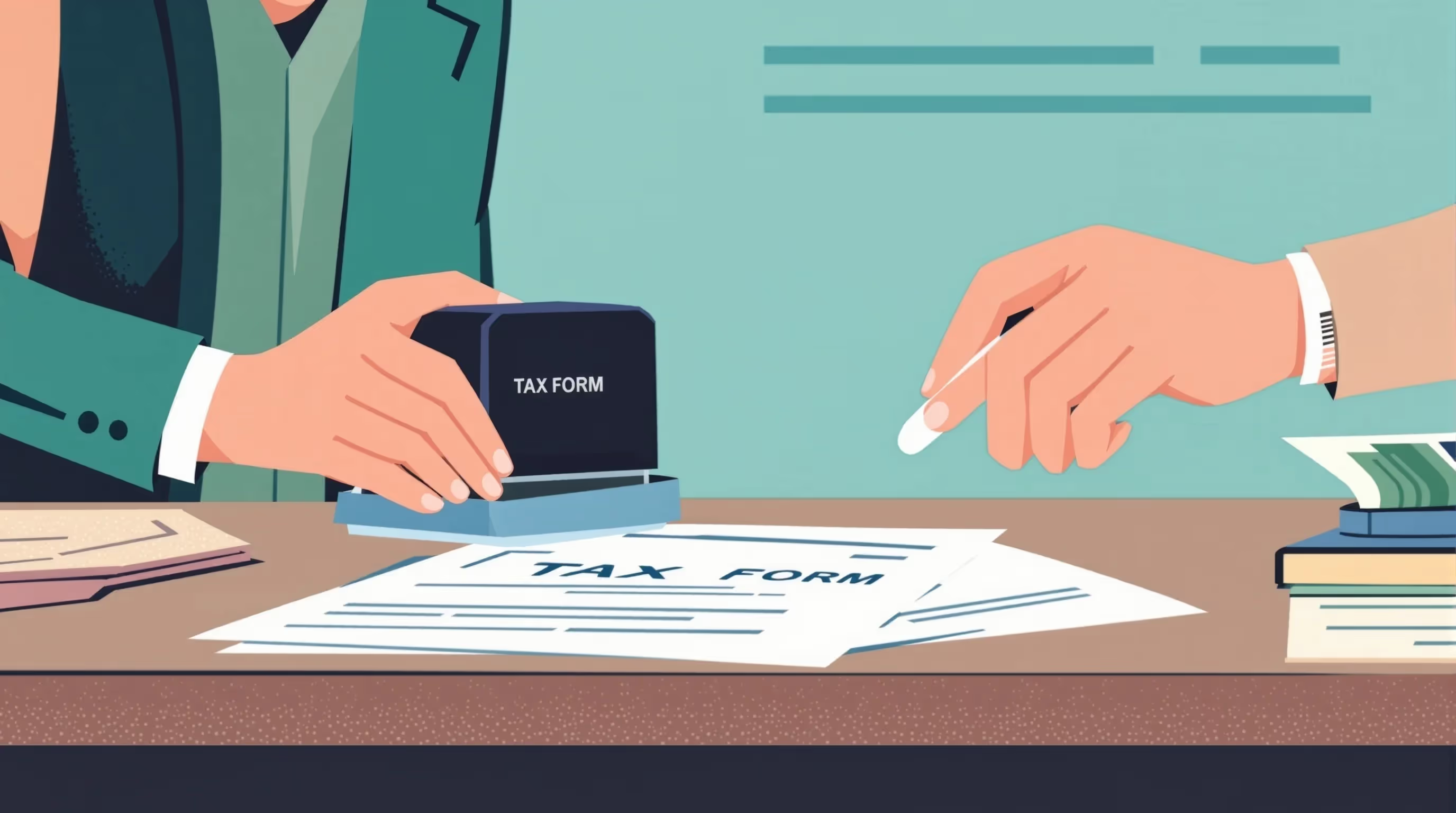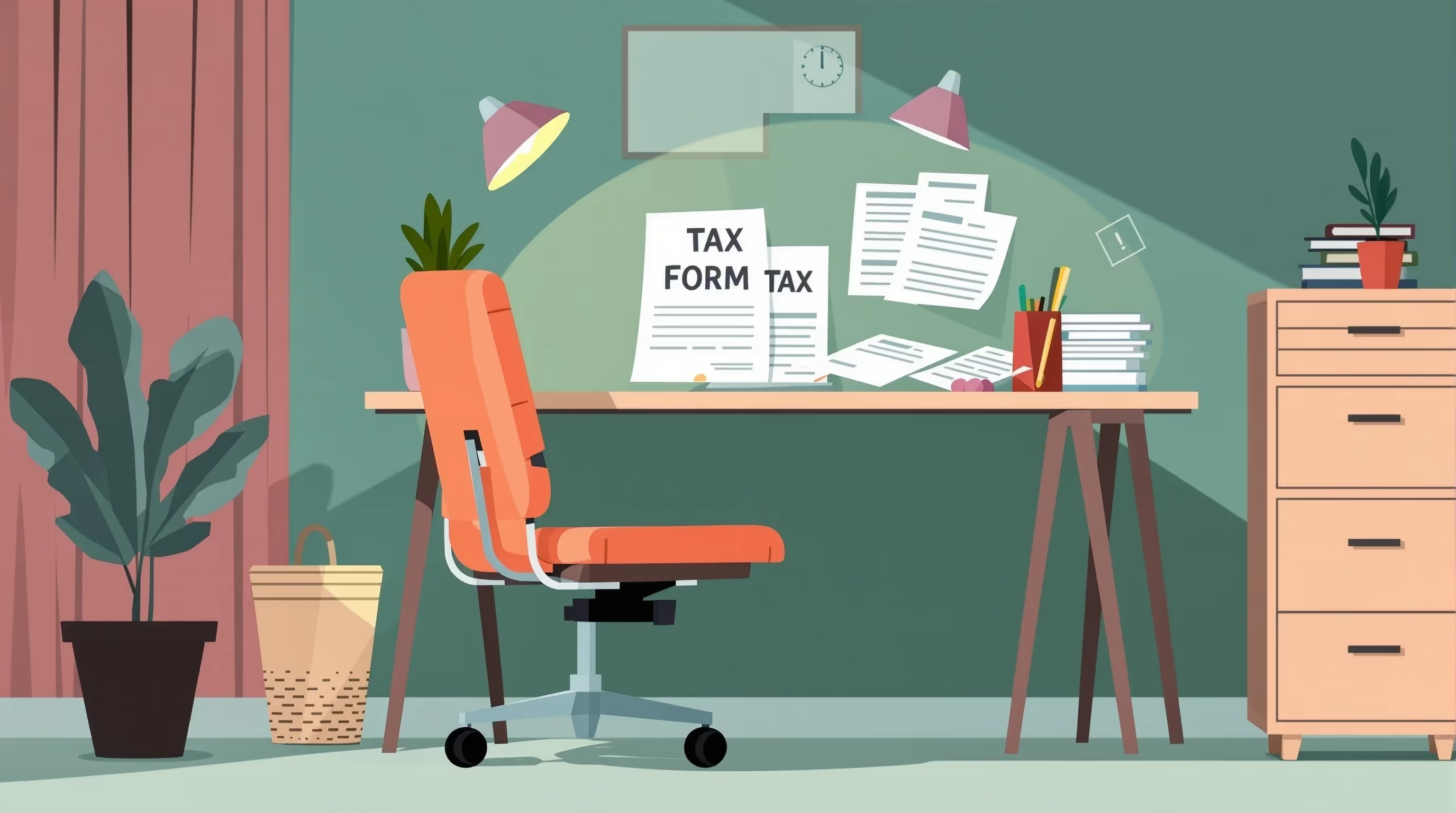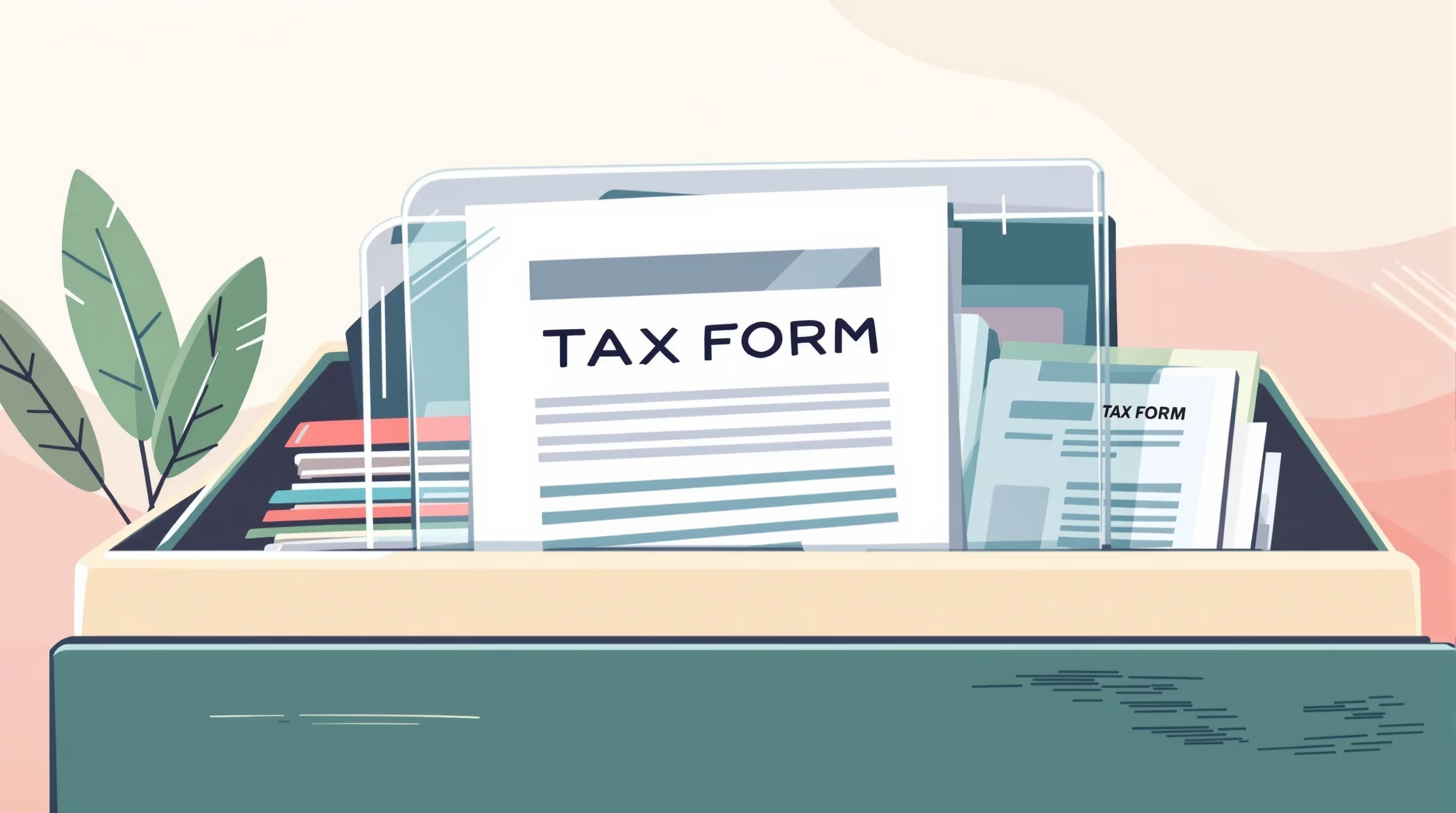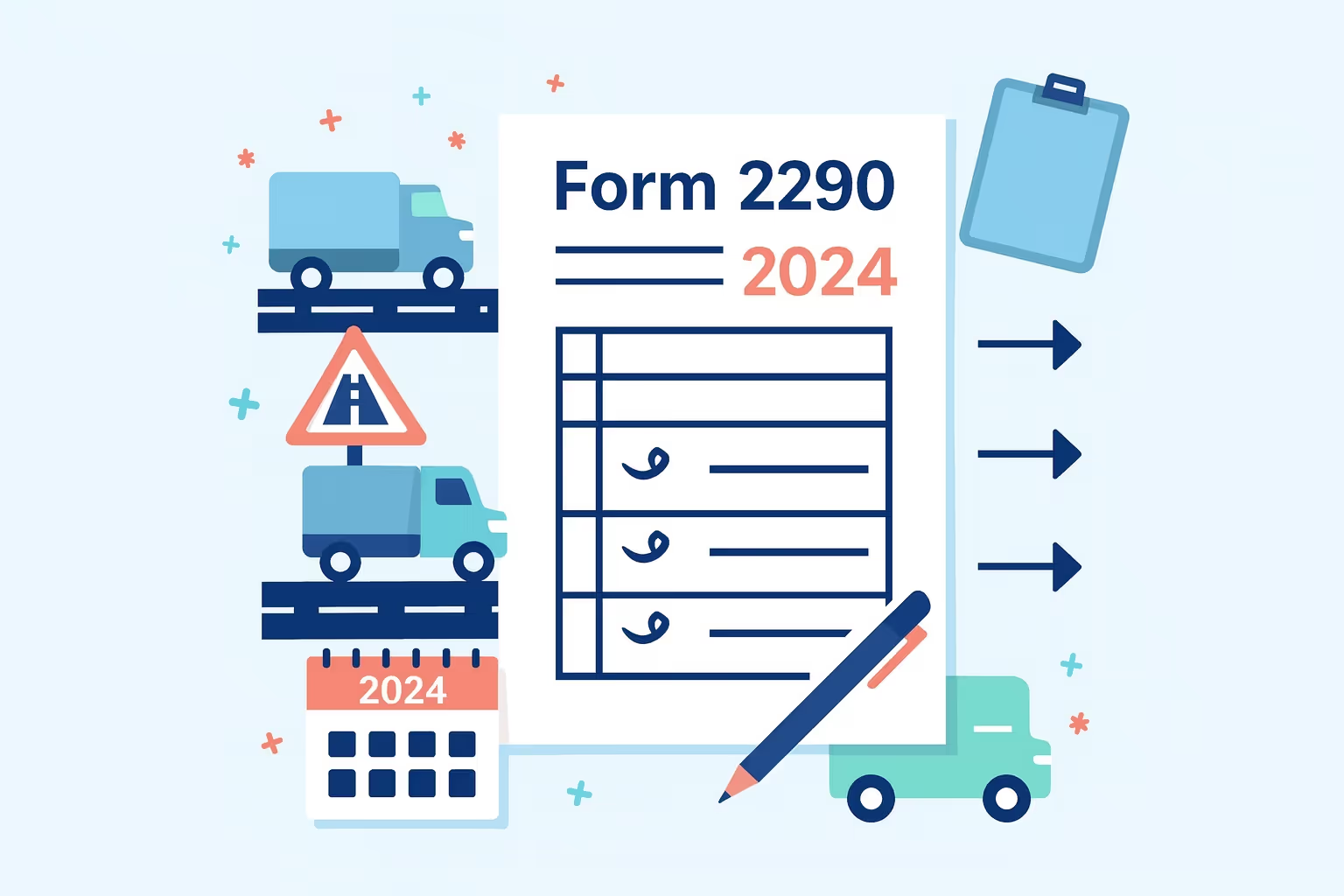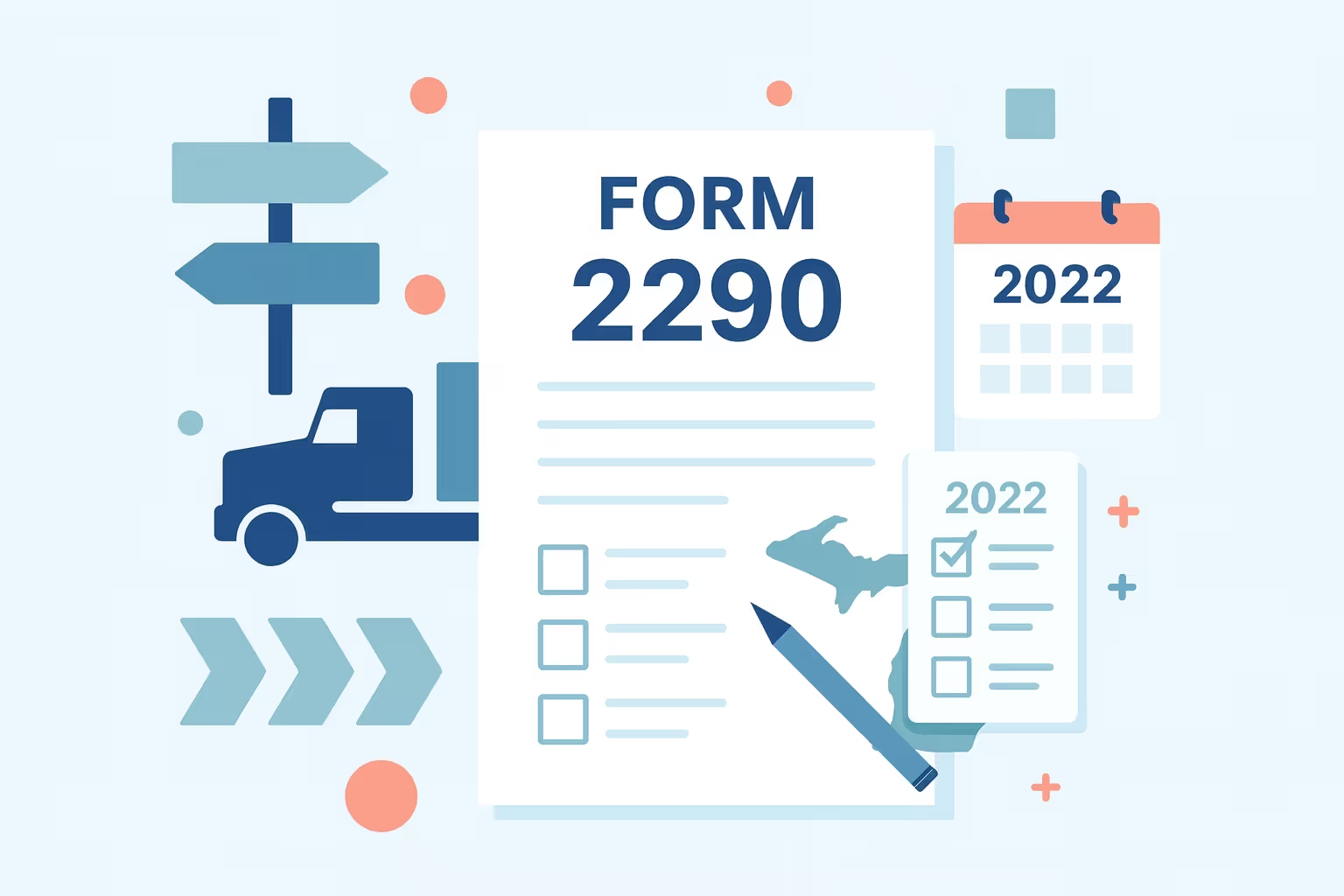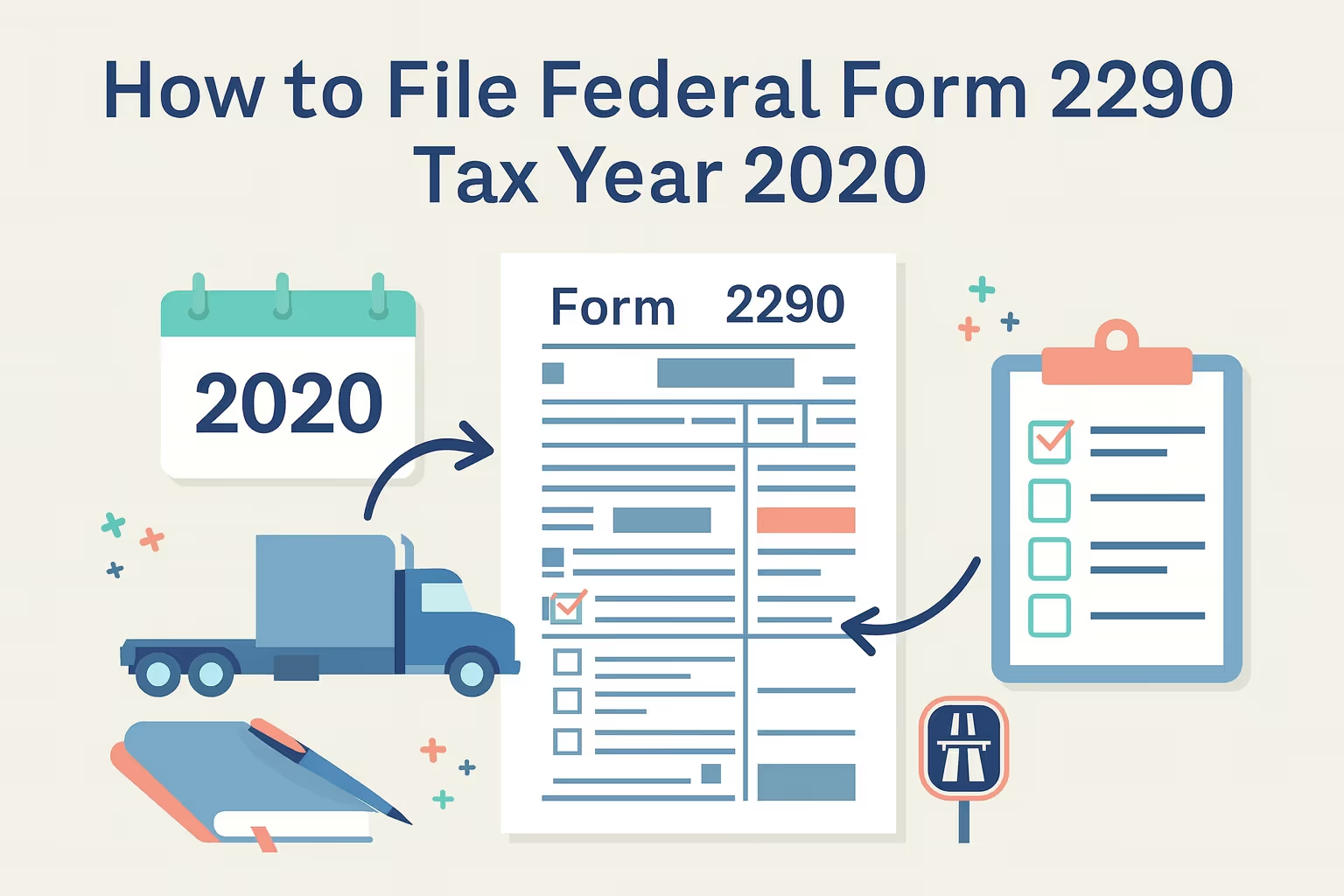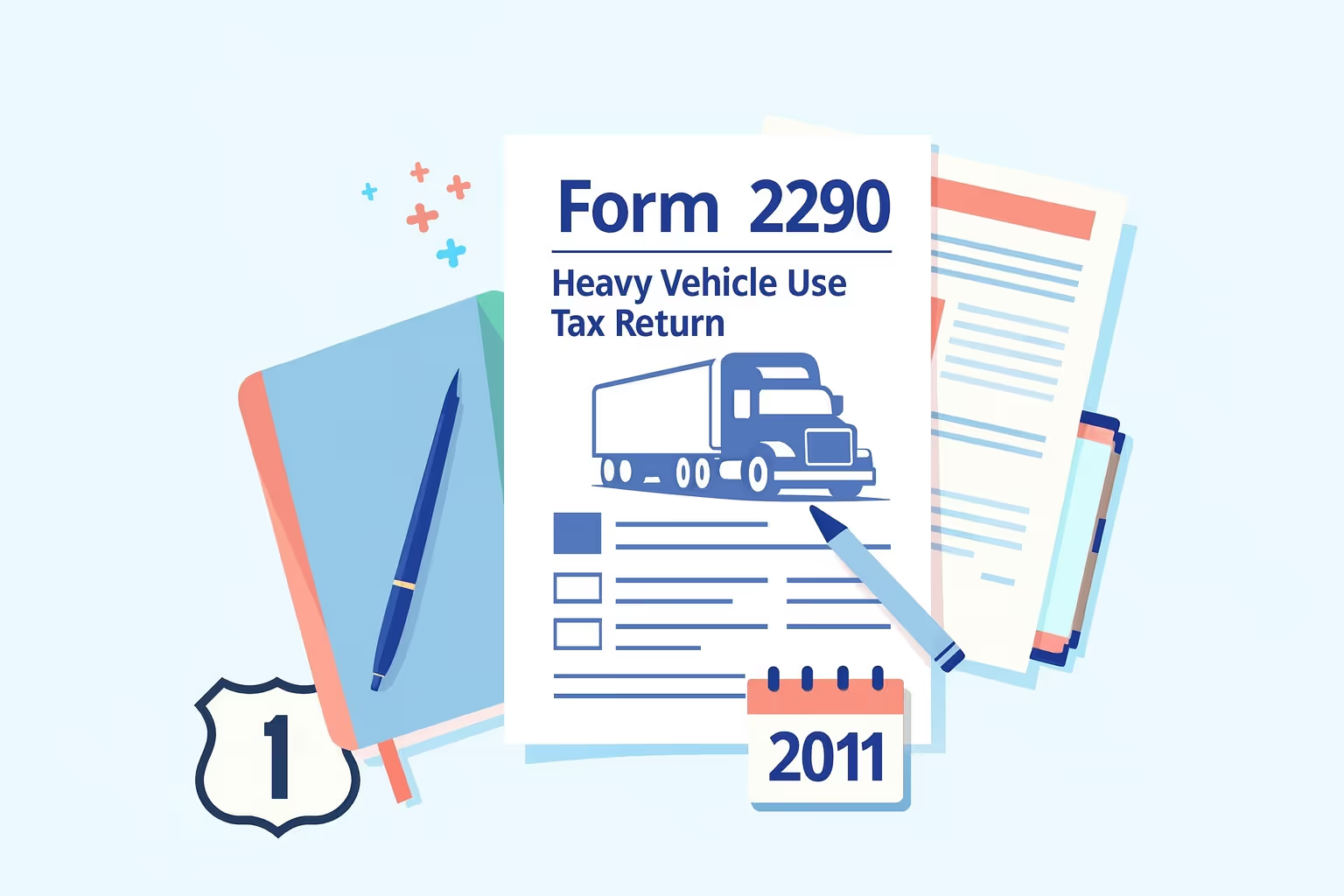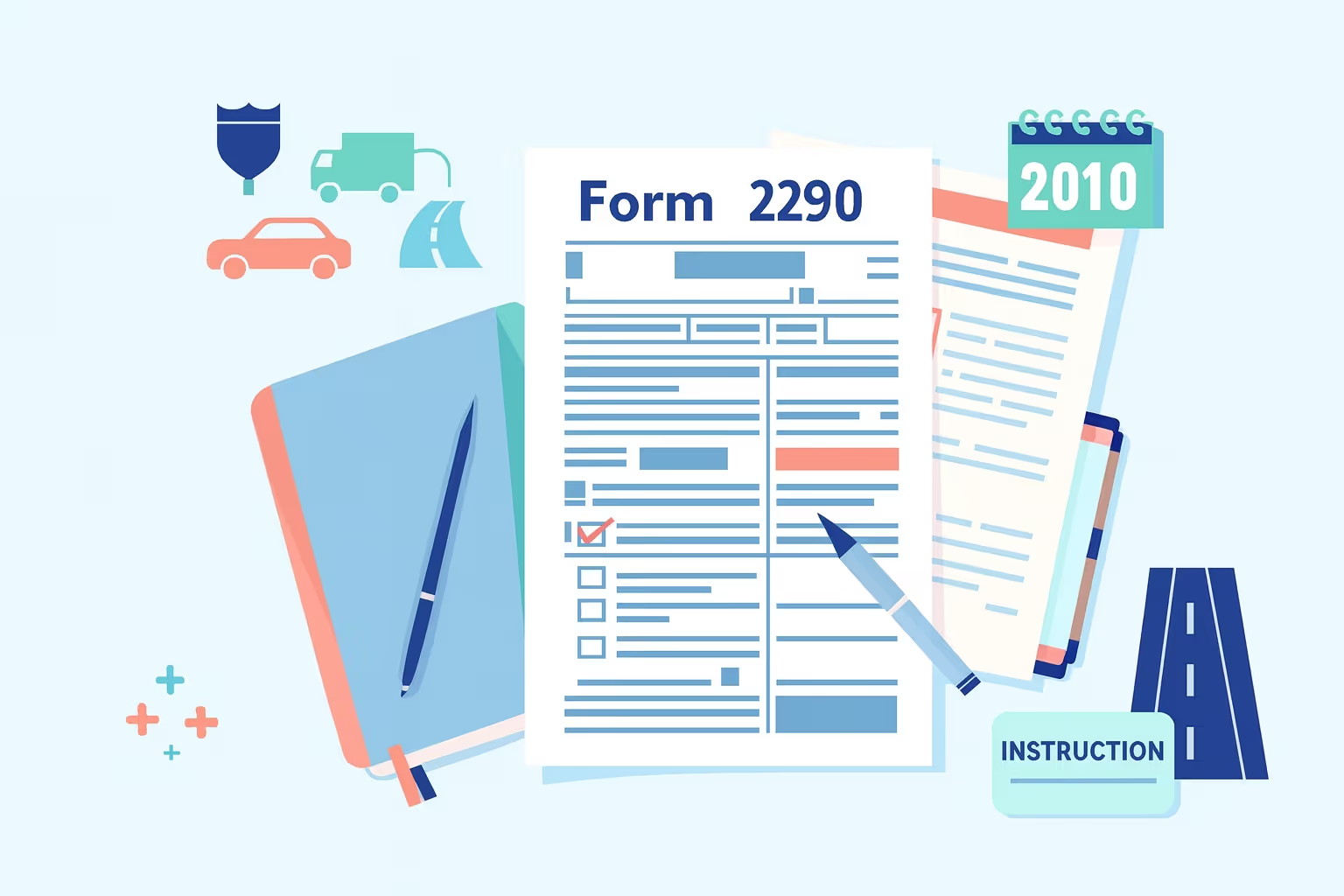Form 2290 2018 Instructions: Step-by-Step Filing Guide
Form 2290 is an IRS tax document used by truck owners, operators, and businesses to report and pay the heavy highway vehicle use tax. This tax applies to highway motor vehicles with a taxable gross weight of 55,000 pounds or more, which are operated on public highways. The funds collected through this tax help maintain and improve federal roads, ensuring that those who rely most on the nation’s highways contribute to their upkeep.
For the 2018 tax period, which runs from July 1, 2018, through June 30, 2019, taxpayers must file Form 2290 with the Internal Revenue Service. Filing this tax form correctly ensures compliance with federal law. It allows vehicle owners to receive a stamped Schedule 1, which serves as proof of payment and is required for vehicle registration with most state DMVs.
This guide provides clear instructions for Form 2290 2018 to help taxpayers understand who must file, how to calculate tax liability, and the proper steps for electronic filing or paper submission. Written for individuals and businesses new to the process, the following sections outline everything needed to file accurately, avoid penalties, and stay compliant with IRS requirements.
Understanding IRS Form 2290 and the Heavy Highway Vehicle Use Tax
What Is Form 2290?
Form 2290 is an IRS tax return used to report and pay the heavy highway vehicle use tax. This tax applies to highway motor vehicles that are registered in the United States and have a taxable gross weight of 55,000 pounds or more. The heavy vehicle use tax helps fund the maintenance and repair of public highways, ensuring that commercial vehicles contributing to road wear share in these costs.
Who Must File Form 2290?
The Internal Revenue Service requires any individual, partnership, corporation, or other organization that registers a taxable vehicle to file this form. Filing is necessary if a vehicle:
- Has a taxable gross weight of 55,000 pounds or more.
- It must either be registered or registered in the taxpayer’s name.
- It is used on public highways during the tax period from July 1, 2018, to June 30, 2019.
Taxpayers must also file when a taxable vehicle is acquired after the start of the tax year or when a used taxable vehicle is placed into service for the first time.
Vehicles Covered and Exempted
Taxable vehicles include trucks, truck tractors, and buses used commercially on public highways. Agricultural vehicles are also subject to the tax if they exceed the 7,500-mile limit. Vehicles exempted from tax include those operated by government agencies, fire and rescue organizations, and qualified blood collector vehicles.
Understanding the scope of the highway vehicle use tax and the filing requirements helps taxpayers stay compliant with IRS rules and avoid penalties. Filing Form 2290 accurately also ensures timely processing and receipt of a valid watermarked Schedule 1, which serves as proof of payment for registration purposes.
Key Updates for the 2018 Tax Year
New IRS Payment Options
For the 2018 tax year, the Internal Revenue Service introduced additional payment methods to simplify the filing process for taxpayers. Filers can now pay using credit or debit cards through approved processors. This option joins existing methods such as the Electronic Federal Tax Payment System (EFTPS), check, or money order. Each payment processor may charge a convenience fee, but the IRS does not collect these fees.
Month of First Use Requirement
Taxpayers must now include the month a vehicle was first driven on a public highway during the tax period. For cars put into service after July 1, 2018, this information guarantees an accurate tax calculation and helps determine the appropriate filing deadline. By including this information, you can avoid filing mistakes that can result in fines or processing delays.
Updated Filing Addresses and Electronic Filing Requirements
The IRS assigned new mailing addresses for specific filing situations beginning with the 2018 period. Filers who pay electronically or owe no tax must send paper returns to the updated IRS processing center. Electronic filing remains strongly encouraged for all taxpayers and is required for any return that reports 25 or more vehicles. E-filing allows faster processing and provides a watermarked Schedule 1 almost immediately after IRS acceptance.
These updates simplify the filing process and make compliance easier for taxpayers managing heavy highway vehicle use taxes.
Step-by-Step Instructions for Filing Form 2290
Step 1: Determine Filing Requirements.
Before filing, taxpayers must verify that they are required to submit Form 2290. Filing is necessary if:
- The vehicle has a taxable gross weight of 55,000 pounds or more.
- The vehicle is registered or required to be registered under the taxpayer’s name.
- The vehicle is used on public highways during the tax period from July 1, 2018, to June 30, 2019.
Step 2: Calculate Taxable Gross Weight.
The taxable gross weight includes:
- The unloaded weight of the vehicle is fully equipped for service.
- The unloaded weight of any trailers or semitrailers customarily used with the vehicle.
- The weight of the maximum load customarily carried on the vehicle.
Taxpayers must ensure that the taxable gross weight meets or exceeds the gross weight declared for state registration.
Step 3: Identify the Correct Tax Category.
The IRS uses categories A through V to assign tax rates based on vehicle weight. Category W applies to suspended vehicles that do not exceed mileage limits.
Example of Tax Categories and Amounts (2018):
- 55,000–75,000 pounds: $100 to $550
- Over 75,000 pounds: $600 or more
Step 4: Determine the Filing Deadline.
Filing deadlines depend on the month the vehicle was first used. For example:
- Vehicles first used in July 2018 must be filed by August 31, 2018.
- Vehicles first used in August 2018 must be filed by October 1, 2018.
If multiple vehicles were first used in different months, a separate Form 2290 must be filed for each month of first use.
Step 5: Complete and Submit Form 2290.
To file accurately, taxpayers should:
- Provide their Employer Identification Number (EIN).
- List each vehicle’s Vehicle Identification Number (VIN).
- Indicate the month of first use and the vehicle’s taxable gross weight.
- Calculate the tax due and select the preferred payment method.
Filing can be completed electronically or by mail, but e-filing is recommended for speed and accuracy.
Completing these steps correctly ensures timely submission, proper tax payment, and quick receipt of a watermarked Schedule 1.
How to File Form 2290: E-File vs. Paper Filing
Electronic Filing (E-File)
Electronic filing is the fastest and most reliable method for submitting Form 2290. It offers immediate confirmation of IRS acceptance and generates a watermarked Schedule 1 within minutes.
Steps for E-Filing:
- Visit the IRS website and choose an authorized e-file provider.
- Create an account and enter vehicle and tax information.
- Select a payment method such as EFTPS, credit, or debit card.
- Review all entries carefully before submission.
- Download and print the watermarked Schedule 1 as proof of payment.
E-filing is mandatory for taxpayers reporting 25 or more vehicles, but recommended for all filers due to its convenience and lower error rate.
Paper Filing
Paper filing is available for those submitting returns for fewer than 25 vehicles or preferring physical documents.
To file by mail, taxpayers should:
- Download Form 2290 and Schedule 1 from the IRS website.
- Complete all required sections in ink.
- Include both copies of Schedule 1 and Form 2290-V if paying by check or money order.
- Mail the documents to the IRS address corresponding to the payment method you used.
Mailing Addresses:
- With payment:
Internal Revenue Service, P.O. Box 804525, Cincinnati, OH 45280-4525. - Without payment or if paying electronically:
Department of the Treasury, Internal Revenue Service, Ogden, UT 84201-0031
Taxpayers who file should allow at least six weeks to receive a stamped Schedule 1.
Choosing between e-file and paper filing depends on the number of vehicles and preferred processing speed, but electronic filing ensures faster confirmation and fewer errors.
Required Schedules and Attachments
Schedule 1: Proof of Payment
Schedule 1 is the key document that proves a taxpayer has paid the heavy highway vehicle use tax. Each vehicle’s Vehicle Identification Number (VIN), category, and month of first use must be listed. The IRS will return a watermarked Schedule 1 after accepting the return. This document serves as proof of payment and is required for vehicle registration with the DMV or renewal of licenses.
Form 2290-V: Payment Voucher
Form 2290-V is used when taxpayers pay by check or money order, rather than using electronic methods. The voucher must include the Employer Identification Number, payment amount, and tax period. Checks should be payable to the United States Treasury, with the EIN and “Form 2290” written on the memo line. Taxpayers should never staple the voucher to the return.
Additional Documentation
Certain circumstances require extra forms or statements, such as:
- An explanation for any VIN correction.
- A suspension statement for vehicles expected to operate below the mileage use limit.
- Proof of sale, destruction, or theft of a taxable vehicle.
- Documentation for credits or refunds claimed for tax paid on sold or destroyed vehicles.
Providing complete and accurate documentation helps ensure smooth IRS processing and prevents unnecessary delays.
Common Errors and How to Avoid Them?
Vehicle Identification Number (VIN) Errors
VIN errors are one of the most frequent causes of rejected returns. Taxpayers should always ensure that all 17 characters are entered correctly and compare the VIN to the registration records. A corrected return must be filed if a VIN was entered incorrectly in a prior filing.
Incorrect Weight or Category
Many taxpayers miscalculate the taxable gross weight or select the wrong category. The gross weight must include the truck, trailer, and maximum load customarily carried. Choosing the incorrect category can result in an inaccurate tax computation and potentially lead to penalties.
Payment and Filing Mistakes
Common payment errors include:
- Submit Form 2290-V when paying electronically.
- Forgetting to include payment with mailed returns.
- Making the check payable to the wrong entity.
- Using a Social Security Number instead of an EIN.
Schedule 1 Errors
Taxpayers often forget to attach both copies of Schedule 1 or omit the month of first use. Inconsistent information between the form and Schedule 1 may cause rejection.
To prevent these errors, taxpayers should review all entries before submission and contact the IRS help line at 866-699-4096 if assistance is needed. A careful review helps ensure proper filing and a faster receipt of the stamped or watermarked Schedule 1.
Suspension and Zero-Activity Rules
Understanding Suspended Vehicles
During the tax period, a suspended vehicle is anticipated to travel 5,000 miles or less on public roads. The threshold for agricultural cars is higher, at 7,500 miles or less. The owner may choose to suspend the vehicle rather than pay the full tax if it satisfies these requirements. Under Category W, suspended cars must still be reported on Form 2290.
Filing and Recordkeeping for Suspended Vehicles
When claiming suspension, taxpayers must:
- Check the suspension box in Part II of Form 2290.
- Include a suspension statement describing the vehicle’s expected mileage.
- Keep detailed records of odometer readings and usage.
- Track highway versus off-highway mileage to verify compliance.
When Mileage Limits Are Exceeded?
If a vehicle exceeds the mileage limit during the tax year, the taxpayer must file an amended return. The full tax must be paid by the last day of the month after the month in which the limit was reached. Penalties and interest may be incurred for noncompliance.
Accurate tracking and documentation are essential to maintaining eligibility for suspension and ensuring proper compliance with IRS mileage and reporting requirements.
Tips for First-Time Filers
Getting Started
First-time filers must ensure they meet all IRS requirements before submitting Form 2290. An Employer Identification Number (EIN) is required, as Social Security Numbers cannot be used for filing. Taxpayers should gather all necessary information, including vehicle titles, VINs, weight certificates, and records of first highway use.
Filing a Used or Newly Acquired Taxable Vehicle
When a taxable vehicle is acquired during the tax year, the taxpayer must report acquisition details and pay the heavy highway vehicle use tax for the remaining months in the tax period. For a used taxable vehicle, the new owner is responsible for filing and paying tax from the date the vehicle is first used on public highways. Proper reporting ensures compliance and avoids penalties for late filing.
Handling Vehicle Changes During the Tax Year
The taxpayer may be entitled to a credit or refund for the tax paid on a vehicle if it is sold, destroyed, or stolen during the tax period. A written statement containing the vehicle's VIN, the date of the event, and proof of sale or loss must be submitted by the taxpayer to be eligible for the credit. Credits can be requested as refunds using Form 8849, Schedule 6, or applied to subsequent Form 2290 filings.
These steps help first-time filers meet all IRS requirements, maintain accurate records, and avoid common mistakes that lead to delays or penalties.
Understanding and Using the IRS Stamped Schedule 1
Importance of Schedule 1
The stamped Schedule 1 serves as official proof that the heavy highway vehicle use tax has been paid for the tax period. Without it, vehicle owners cannot register or renew registration with state DMVs or the Department of Transportation. The document includes a watermarked Schedule 1 returned by the IRS after acceptance of an electronic or paper filing.
How to Obtain Schedule 1?
Schedule 1 is sent to e-filed taxpayers as soon as the IRS completes processing their return. A stamped Schedule 1 will be mailed to paper filers; this process may take up to six weeks. By contacting the IRS, taxpayers can request a duplicate document if they have lost or damaged their original document. Keeping copies of Schedule 1 on hand is crucial for verification during inspections or renewals for vehicles operating in the District of Columbia or across several states.
State and DMV Requirements
Vehicles weighing 55,000 pounds or more must register using Schedule 1 in the majority of states and the District of Columbia. Vehicle owners should keep both digital and paper copies for use in registration or compliance checks. Having proof of payment on hand also helps speed up the process of obtaining new tags or special permits.
Proper handling of Schedule 1 ensures legal operation on public highways and compliance with federal and state vehicle registration requirements.
Frequently Asked Questions
What is Form 2290, and who is required to file it?
Form 2290 is the IRS form used to report and pay the Heavy Highway Vehicle Use Tax. It applies to highway motor vehicles with a taxable gross weight of 55,000 pounds or more that operate on public highways. Taxpayers must file during the applicable tax period if they own or register a taxable vehicle. The Internal Revenue Service requires filing even when a used taxable vehicle is acquired mid-year.
When is the filing deadline for Form 2290?
The filing deadline depends on the month of first highway use. For vehicles first used in July, taxpayers must file by August 31. The tax period runs from July 1 through June 30 of the following year. Filing promptly helps ensure that the watermarked schedule is received without delay. Late filing may result in penalties or fees from the Internal Revenue Service.
Can Form 2290 be filed electronically?
Yes, electronic filing (e-file) is available through approved IRS providers and is recommended for faster processing. E-filed returns are processed quickly, and taxpayers usually receive a watermarked Schedule 1 within minutes of IRS acceptance. Electronic filing also reduces errors commonly found in paper returns and ensures compliance with the latest Form 2290 instructions for 2018.
What should taxpayers do if a vehicle is sold, destroyed, or stolen?
If a taxable vehicle is sold, destroyed, or stolen during the tax period, taxpayers can claim a credit for the tax paid on the car. To do so, they must provide details such as the vehicle identification number, date of loss, and proof of sale or destruction. The credit can be used on future filings or requested as a refund using IRS Form 8849, Schedule 6.
What happens if a vehicle exceeds the mileage use limit?
When a suspended vehicle exceeds 5,000 miles on public highways (7,500 miles for agricultural vehicles), the taxpayer must file an amended return and pay the heavy vehicle use tax for the remainder of the tax period. The amendment ensures proper reporting and compliance with IRS requirements. Filing promptly helps taxpayers avoid penalties and maintain an accurate vehicle use tax return record.
How does a taxpayer claim suspension for a vehicle?
A taxpayer can claim suspension when a heavy vehicle is expected to operate 5,000 miles or less during the tax period. To claim suspension, the taxpayer must complete Part II of Form 2290, include a suspension statement, and report all suspended vehicles under Category W on Schedule 1. Proper documentation is required to verify mileage and eligibility for suspension.
Where can taxpayers find help with Form 2290 filing questions?
Taxpayers can visit the official IRS website for Form 2290 2018 instructions, payment details, and updates. They may also call the IRS Form 2290 Help Line at 866-699-4096 for direct assistance. Additional support is available at local DMV offices or the District of Columbia motor vehicle registration offices, where proof of the watermarked schedule may be required for registration purposes.








